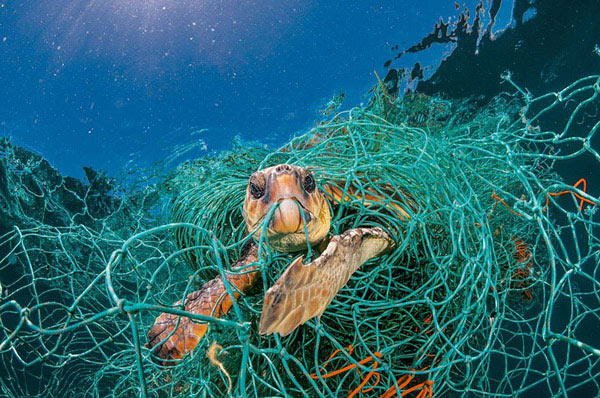How are people using plastic to destroy nature?
The world is emitting 300 million tons of plastic waste per year, and nearly one-third of plastic bags that people use are not collected and processed. Consequently, plastic and plastic waste discharged into the environment increases constantly and is present everywhere. They are day by day destroying the habitat and the animal world, especially marine animals.
The images taken in nature below will show us the tremendous devastation of plastic waste to the environment and the animals.

An unfortunate stork caught a plastic bag. This photo was taken at a landfill in Spain and luckily the stork was freed by the photographer, otherwise it could die. The stork's body can decompose in a short time but the plastic bag is not.

A turtle is caught in the old net that is thrown away trying to escape to catch up on the surface of the breathing water. Luckily, it was rescued by the photographer from the net. The photo was taken in a remote sea off the Mediterranean.

A borrowed snail must use a plastic cover to protect its soft abdomen taken in Okinawa, Japan. The natural hard shell of the snail has been exploited by humans for sale, while leaving plastic waste.

The seahorse must cling to a cotton swab of human ears to move through the flow. In the Indonesian island of Sumbawa, algae, algae or other natural debris have been replaced by waste.

An alarming number is worldwide with nearly 1 million plastic water bottles sold every minute.

Plastic waste is spilling into the wild natural world, causing many animals to live in a world full of plastic. In the picture are hyenas who are foraging on Harar landfill, in Ethiopia.

There are about 8 million tons of plastic waste discharged to the ocean each year and it is reported that more than 700 marine animals have eaten or are more likely to get caught in plastic.

Experts warn that by 2050 the ocean will be more garbage than marine life and nearly all seabirds on Earth will eat plastic.

According to the United Nations report, there are 1000 plastic bags consumed per minute around the world but only 27% of them are processed and recycled.
You should read it
- Chemical recycling can be a solution to the problem of plastic waste pollution
- The AI system helps detect plastic waste in the ocean through satellite images
- Manufacturing electric cables from plastic waste - The great plan for the situation of plastic waste pollution in the world today
- Picking up marine waste sorted into impressive works
- Pests can eat plastic, savior of man-made plastic waste
- Microplastics discovered in an 11-year-old ice core in Antarctica
- How long does it take waste to decompose?
- Plastic containers are the latest threat to coral reefs
- Discovered 'tattoo' lobster Pepsi logo and anxiety about the sea future
- Bioplastic biodegradable in natural environment made from shrimp shells
- Examine the process of turning garbage into street bricks and clothes in Japan
- The Earth has more than 8 billion tons of plastic, weighing about 1 billion elephants
May be interested

17 signs that the 6th great extinction - the nightmare of humanity is about to sweep through the earth

We are inhaling super fine dust PM2.5, the most dangerous dust in the world can penetrate into human body cells

2017 may be the hottest year in the record breaking history of 2016

You will be startled when watching the video describing the process of Earth's hotness in the past 100 years

Startled with the harmful effects of solar cells on the environment

The Earth has more than 8 billion tons of plastic, weighing about 1 billion elephants






 What is ABS plastic? Applications of ABS plastic in life
What is ABS plastic? Applications of ABS plastic in life Things to know when using food plastic
Things to know when using food plastic Chemical recycling can be a solution to the problem of plastic waste pollution
Chemical recycling can be a solution to the problem of plastic waste pollution How dangerous chemicals are in plastic consumer products
How dangerous chemicals are in plastic consumer products What is PP plastic? These products are manufactured from PP plastic
What is PP plastic? These products are manufactured from PP plastic Deodorize plastic containers easily with 7 simple tips
Deodorize plastic containers easily with 7 simple tips